Seth Ward House Historical Marker
Introduction
Text-to-speech Audio
This expansive Greek Revival mansion was constructed around 1871 for the family of Seth Ward, a frontier trader who arrived in Independence in 1837 and joined a fur trading expedition. Over the next three decades, Ward earned a fortune by providing supplies to frontier military units and later outfitting explorers and settlers at Fort Laramie. After several decades on the frontier, Ward returned to the Kansas City area in 1871. He and his second wife, Mary Ward, daughter of Westport hotelier John Harris, purchased this land from William Bent, another influential and successful trader and land owner in Kansas City history. At that time, Ward's property extended from 51st to 55th Street and Wornall Road to the Kansas-Missouri state line. The property enjoys a rich history that goes beyond Ward and Bent, entailing Mormons, Native Americans, western expansionism, Kansas City's first elected Mayor, and the bloody Battle of Westport during the Civil War in 1864, which took place on the historic property.
Images
Seth E. Ward house
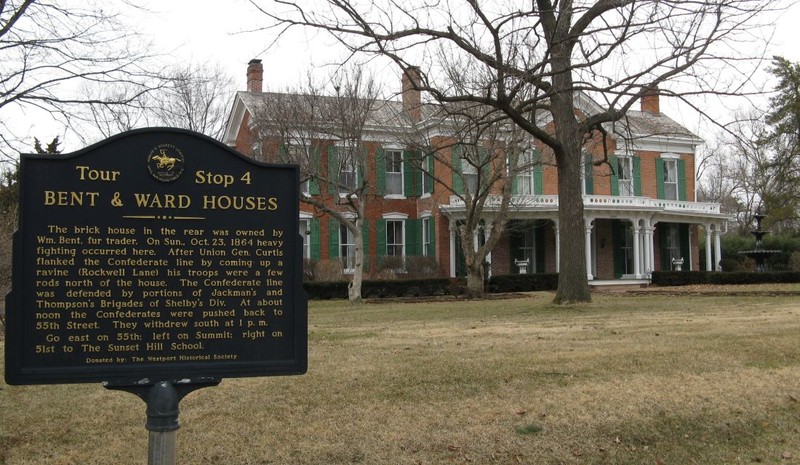
Map Key 1
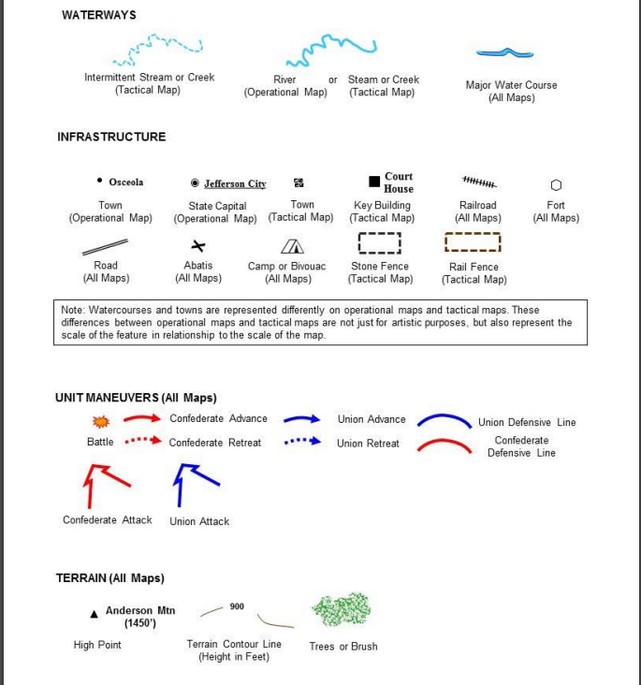
Map Key 2
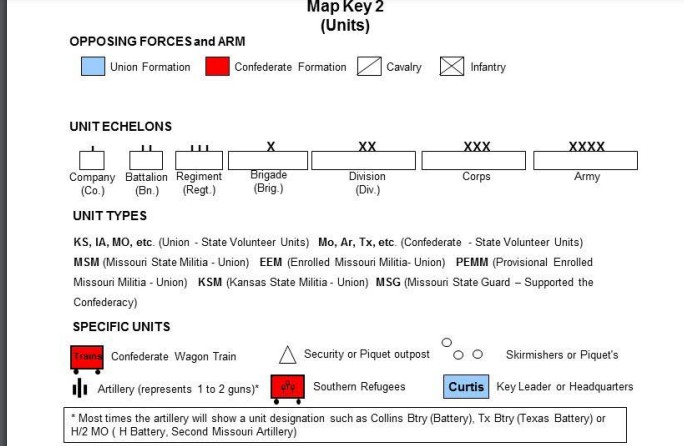
Battle of Westport Map 1 Initial Positions
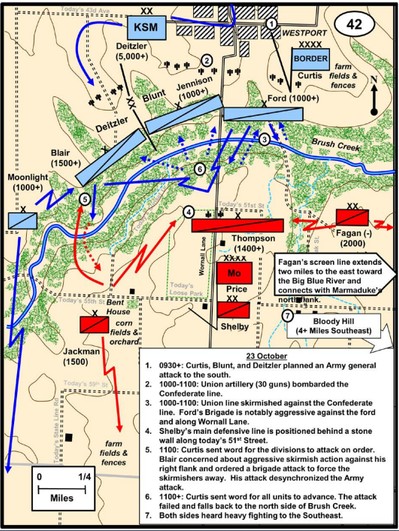
Battle of Westport Map 2 Curtis following George Thoman's Path
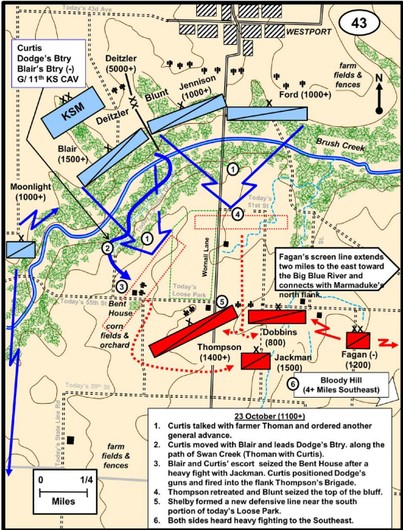
Backstory and Context
Text-to-speech Audio
Until 1825, Native American tribes such as the Kansa and Osage occupied most of the land now known as the Kansas City area. In that year, the Indians were compelled to negotiate with the federal government and subsequently accepted lands further west and southwest. This removal coincided with several other forcible and negotiated displacements spearheaded by President Andrew Jackson, including the 1830 Indian Removal Act.
Early in 1831, a group of Mormon missionaries and families arrived in Jackson County, hoping to settle the region and also convert Native Americans. The small congregation, which had only been organized one year earlier by Joseph Smith in Fayette, New York, on April 6, 1830, believed that Jackson County was a place of Zion (the New Jerusalem). The Mormons settled on farms, opened shops, established a printing press, built a temple, and established a school. However, they only briefly preached to Native Americans before the Department of Indian Affairs forced them to leave, accusing Mormons of disturbing the peace between the indigenous populace and a growing number of non-Native residents. Meanwhile, other pioneers of European descent, who mainly were Baptists and Methodists, strongly opposed the pressure of the Mormon settlers because of their belief in the Book of Mormon. The fact that Mormons generally held anti-slavery beliefs in a slave state was also a cause for concern for some Missouri settlers. As a result, violent interactions transpired between Mormons and other Christians, eventually forcing Mormons to flee Jackson County in November 1833. By 1838, the Mormons left Missouri completely. Alexander W. Doniphan, one of the attorneys hired by the Mormons to gain compensation for the land they fled, received the property now known as the Ward Homestead as part of his fee.
In 1840, Doniphan sold a portion of the now-historic property to Dr. Johnston Lykins. In addition to practicing medicine, Lykins served as a Baptist missionary who interacted with the Shawnee Indians. After a few years, he abandoned the missionary work and moved to the rapidly developing Kansas City, where he helped found the first newspaper, the city's Chamber of Commerce, and is considered to have been Kansas City's first "duly elected mayor" in 1854 and 1855. A Westport farmer named William Matney purchased the eventual Ward property from both Doniphan and Lykins on the same day, sometime before the U.S.-Mexican War.
After Matney died in 1857, Matney's son-in-law took over the land, and he subsequently sold the land in 1858 to William W. Bent. He and his brothers established a trade business along the Santa Fe Trail. Much of the trading took place at a fort Bent built (Bent's Fort) in the 1830s along the Arkansas River in present-day Colorado. Bent not only negotiated peace among the many Indigenous nations in the High Plains and along the Arkansas River but routinely served as a mediator in disputes among Native Americans and the U.S. government. In 1835, Bent married Owl Woman, the daughter of Cheyenne chief and medicine man White Thunder; Bent became an accepted member of the Cheyenne nation. Bent's Cheyenne Wife died in 1847 and by the 1850s, Bent no longer used Fort Bent as a central location for trading, eventually selling it to the federal government in 1859. While owning the now-historic Ward property, he worked as an agent to the Cheyenne and Arapaho, continued his trading business, and freighted goods for the government.
During the Civil War, some of the events of the Battle of Westport transpired on the Ward property, which was then William Bent's farm. On October 23, 1864, Union and Confederate forces launched artillery, fired weapons, and engaged in hand-to-hand combat on or near Bent's farm. The Battle of Westport was the largest Civil War battle west of the Mississippi River, with combined casualties and deaths exceeding 3,000; the defeat effectively ended any Confederate military action in Missouri. Seth E. Ward, who exemplified the "rags to riches" narrative as a former hired hand on trading expeditions in the late 1830s, purchased this land from Bent's estate and widow after the Civil War.
At age twelve, in 1832, Seth Ward lost his father and consequently had to work to support his family. Ward left his Virginia home and worked as a farmer's apprentice in Indiana but left one year later and traveled by foot for six months to return home. His mother found enough money for Seth to leave home again to find work, but after three years, in 1837, he arrived as a penniless seventeen-year-old in Independence, Missouri. However, in Missouri, he found work as a laborer in the fur trading business, living off the land and routinely sleeping in the open on bare ground for two decades. Still, he learned business and other lessons that eventually earned him a fortune later in life, including learning several Native American languages and marrying a Native American woman.
Over time, Ward went from a greenhorn trading worker to a highly profitable trader, eventually gaining the position of post sutler (a civilian authorized to operate a store on or near a military camp or fort) at Fort Laramie in the southeast corner of present-day Wyoming, a role he maintained until 1871 when he moved back to Westport, Missouri. Ward's accumulated wealth allowed him to retire in his early 50s, when he and his second wife Mary, daughter of Westport hotel owner Colonel John Harris, purchased the now-historic property from Bent's estate. He commissioned acclaimed architect Asa Beebe Cross to design the mansion where Ward lived the rest of his life; the mansion sat within walking distance of the spot where, as an impoverished teenager, he had camped on his first trip west.
Seth and Mary Ward continued to add to their property, eventually owning several hundred acres. But, as Kansas City rapidly expanded in both size and population, its boundaries eventually pushed past the Ward estate. Seth sold large tracts of his land to various developers. The Ward family maintained a significant portion of the land and the mansion until they sold it in 1942.
Marker Inscription: The brick house in the rear was owned by Wm. Bent, fur trader. On Sun., Oct. 23, 1864 heavy fighting occurred here. After Union Gen. Curtis flanked the Confederate line by coming up a ravine (Rockwell Lane) his troops were a few rods north of the house. The Confederate line was defended by portions of Jackman's and Thompson's Brigades of Shelby's Div. At about noon the Confederates were pushed back to 55th Street. They withdrew south at 1:00 p.m.
Sources
Beckenbaugh, Terry. "Battle of Westport" Civil War on the Western Border: The Missouri-Kansas Conflict, 1854-1865. The Kansas City Public Library. Accessed April 19, 2024. https://civilwaronthewesternborder.org/encyclopedia/battle-westport.
Coleman, Daniel. "Seth Ward: Frontier Trader, 1820-1903." Kansas City Public Library. kchistory.org. 2008. https://kchistory.org/document/biography-seth-ward-1820-1903-frontier-trader.
Collins, Charles D. Battlefield Atlas of Price’s Missouri Expedition of 1864. Fort Leavenworth, KS: Combat Studies Institute, US Army Combined Arms Center, 2016.
Euston, Diane. "Dr. Johnston Lykins, A Missionary, Translator, Physician, and Civil Leader." Martin City Telegraph. January 28. 2024.https://martincitytelegraph.com/2024/01/28/dr-johnston-lykins-a-missionary-translator-physician-and-civic-leader/.
Hyde, Anne. Empires, Nations, & Families: A History of the North American West, 1800-1860. Lincoln: University of Nebraska Press, 2011.
"Mormons: Mormons in Missouri." Kansas City Public Library. kchistory.org. Accessed April 19, 2008. https://kchistory.org/research/mormons.
Ryder, Elaine. "Nomination Form: Ward, Seth E., Homestead; Ward House." National Register of Historic Places. mostateparks.com. 1977. https://mostateparks.com/sites/mostateparks/files/Ward%2C%20Seth%20E.%20Homestead.pdf.
"Santa Fe Trail Historic Sites: Seth Ward House." National Trails office of the National Park Service and the University of New Mexico. Accessed April 19, 2024. https://historic-trails.unm.edu/sites/seth-ward-house.html.
Wishart, David, ed. "Fur Trade." Encyclopedia of the Great Plains. University of Nebraska-Lincoln. 2011. http://plainshumanities.unl.edu/encyclopedia/doc/egp.ind.022.
By Americasroof at English Wikipedia, CC BY-SA 3.0, https://commons.wikimedia.org/w/index.php?curid=17997800
Collins, Charles D. Battlefield Atlas of Price’s Missouri Expedition of 1864. Fort Leavenworth, KS: Combat Studies Institute, US Army Combined Arms Center, 2016
Collins, Charles D. Battlefield Atlas of Price’s Missouri Expedition of 1864. Fort Leavenworth, KS: Combat Studies Institute, US Army Combined Arms Center, 2016
Collins, Charles D. Battlefield Atlas of Price’s Missouri Expedition of 1864. Fort Leavenworth, KS: Combat Studies Institute, US Army Combined Arms Center, 2016
Collins, Charles D. Battlefield Atlas of Price’s Missouri Expedition of 1864. Fort Leavenworth, KS: Combat Studies Institute, US Army Combined Arms Center, 2016.
